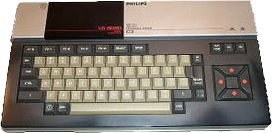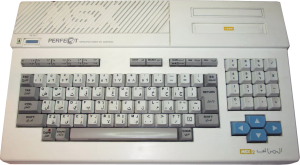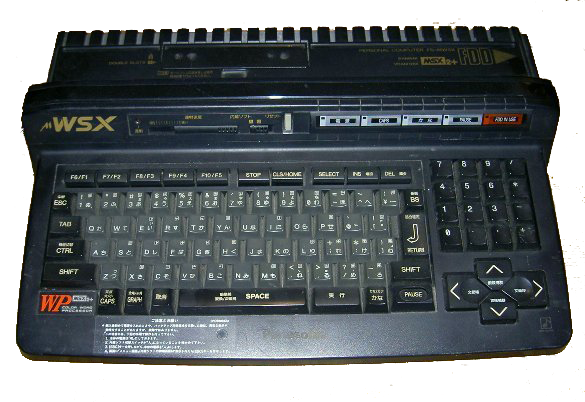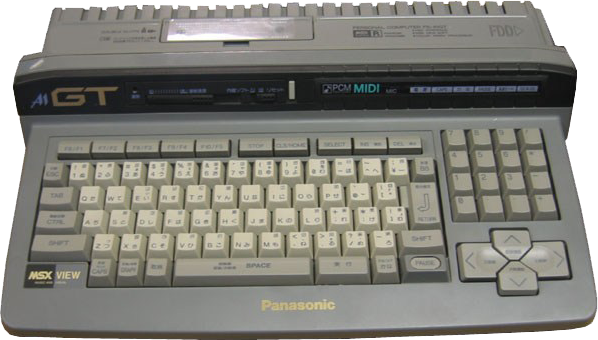Content
MSX
MSX was the name of a standard, in the 1980s, of a personal computer architecture

It was a Microsoft led attempt to create a unified standard for hardware manufacturers, conceived by Microsoft Japan's sole executive, Kazuhiko Nishi
Despite Microsoft's involvement, MSX-based machines were rarely seen in the United States, but were very popular in other markets
In the end, 5 million units were sold worldwide
Nishi proposed MSX as an attempt to create a single standard within the industry of personal computers
Inspired by the success of VHS as a standard for videocassette recorders, many Japanese electronics manufacturers, along with Goldstar, Philips and Spectravideo built and promoted MSX computers
Any piece of hardware or software with the logo of MSX was compatible with the products MSX from other manufacturers
Specifically, the form and function of the expansion cartridges were part of the standard; any MSX expansion or game cartridge would work on any MSX computer
Description
The Nishi standard consisted mainly of several off-the-shelf components; the main CPU was a 3.58 MHz Zilog Z80, the graphics chip was a Texas Instruments TMS9918 with 16 KB (KiB) of dedicated VRAM, and sound was provided by the AY-3-8910 chip manufactured by General Instrument (GI)
These components, along with Microsoft's MSX BASIC, made the MSX a competitive, if somewhat expensive, personal computer package
This design was very similar to the Spectravideo SV-328 personal computer, but there was not complete compatibility between them
Spectravideo later released a system, the SV-728 that adhered to the MSX standard
Before the appearance and great success of the Nintendo Famicom, MSX was the platform for which major Japanese game studios, such as Konami and Hudson Soft, produced their titles
The series Metal Gear was originally written for the hardware of the MSX
History
In the 1980s, Japan was in the midst of an economic awakening
Large Japanese electronics companies could have been successful in the early computer market if they had made a concerted effort in the late 1970s
Their combined design and manufacturing power could have allowed them to produce competitive machines, but they initially ignored the personal computer market and appear to have hesitated to do business in a market where no industrial standard existed
When a large number of large Japanese firms announced their plans to introduce the MSX machine, it caused a wave of panic in the US industry
However, Japanese companies avoided the highly competitive personal computer market in the United States, which was in the midst of a price war over Commodore
Only Spectravideo and Yamaha marketed, briefly, the machines MSX in the united States
The Spectravideo MSX technology had very little success, and Yamaha's CX5M model, created to interface with various types of MIDI equipment, was considered more of a digital music processing tool than a personal computer standard
During the 1980s, Europe became the largest market for computer games (as opposed to console games) in the world, and the extremely popular computers Commodore 64 and Sinclair ZX Spectrum they dominated the market
By the time MSX launched several 8 bit personal computers in Europe, the other computers, which were more popular, were already too late to capture the European 8 bit computer market
As a result, the MSX never became the global standard that its creators had envisioned, as it never took off in the United States or most of Europe
In Japan and South Korea, MSX was the leading personal computer system in the 1980s
It was also popular in the Netherlands, Spain, Brazil, some Arab countries and the Soviet Union, where networked models of the Yamaha MSX 2 were used to teach computer science in schools
The exact meaning of the abbreviation 'MSX' is still a matter of debate
It is believed that it stood for 'MicroSoft eXtended', referring to the included MSX-BASIC programming language, specifically adapted by Microsoft for the MSX system
However, according to Kazuhiko Nishi on a visit to Tilburg in the Netherlands, he stated that MSX stands for 'Machines with Software eXchangeability'
The MSX-DOS operating system had CP/M support and was similar to MS-DOS
In this way, Microsoft may have promoted MSX for home use while promoting MS-DOS-based personal computers in office environments
MSX released four generations:
- MSX 1 (1983) 8 bit computer based with Z80 microprocessor
- MSX 2 (1986) 8 bit computer based with Z80 microprocessor
- MSX 2+ (1988) 8 bit computer based with Z80 microprocessor
- MSX turbo R (1990) 16 bit computer based on the Zilog Z800 microprocessor known as R800. It was not successful due to lack of support and the increase in popularity of the already well-established on the market, IBM PC Compatible. Its production ended in 1995
In total, 5 million MSX computers were sold, making it relatively popular but not the global standard it was intended to be
Compared to competing 8 bit computers, Commodore 64 sold 17 million units in its entire life cycle, Apple II sold 6 million units, Amstrad CPC sold 3 million units and Tandy TRS-80 sold 250,000 units
Resurgence of MSX
In 2001, Kazuhiko Nishi started an 'MSX revival' thanks to the official MSX emulator called MSXPLAYer
It is the only emulator official MSX
All the copyrights of the MSX are maintained by the MSX Association
In 2004, the Dutch company Bazix announced that they had become representatives of the MSX Association in Europe, offering contact in English for any questions related to MSX trademarks and copyrights
On October 17, 2006, Bazix launched WOOMB.Net, a website selling MSX games (translated into English if necessary), with a selection of 14 games
In Japan, game sales began earlier, through Project EGG
WOOMB.Net was the English counterpart to this (and other) Japanese services offered by D4 Enterprise
In August 2006, D4 Enterprise announced the release of a new MSX2-compatible system called “one chip-MSX”, a system based on an Altera Cyclone EP1C12Q240C8 FPGA
The “one chip-MSX” was similar in concept to the C-One, a clone of Commodore 64 which was also based on a single FPGA chip
The new MSX system could be found in a case made of transparent blue plastic and could be used with a standard (or TV) monitor, along with a PC keyboard
It had two MSX cartridge slots and supported the MSX-MUSIC and SCC+ audio extensions
An SD/MMC-flashcard could be used as an external storage medium, emulating the drive needed to boot MSX-DOS
Thanks to its VHDL programmable hardware, it was possible to add new hardware extensions to the device simply by running a reconfiguration program under MSX-DOS
The “one chip-MSX” also had two USB connectors that could be used after adding supporting VHDL codes
In 2006, Nintendo Japan posted on its Virtual Console website that MSX games would be available for the Wii Virtual Console emulator
In February 2007, it was confirmed again and announced that the games would cost 800 Wii Points and would be available by Spring 2007 (Japan only, at least initially)
Games
Some of the video game franchises that became popular on the MSX:
| Name | Company | Year |
|---|---|---|
| Bomberman | Hudson Soft | 1983 |
| Metal Gear | Konami | 1987 |
| Parodius | Konami | 1988 |
| Puyo Puyo | Compile | 1991 |
Others had multiple releases on MSX, including some exclusive titles for the system or versions of games converted from other formats:
| Name | Company | Year |
|---|---|---|
| Castlevania (as Vampire Killer) | Konami | 1986 |
| Dragon Quest | Enix | 1986 |
| Final Fantasy | Squaresoft | 1989 |
| Gradius (Nemesis) | Konami | 1985 |
| Penguin Adventure | Konami | 1986 |
| SD-Snatcher | Enix | 1986 |
| Knightmare | Konami | 1986 |
| Ys – Ancient Ys Vanished Omen | Origin | 1988 |
Manufacturers of MSX computers
MSX 1
Spectravideo (USA), Philips (Netherlands), Al Alamia (Saudi Arabia), Sony, Sanyo, Mitsubishi, Toshiba, Hitachi, National, Panasonic, Canon, Casio, Pioneer, Fujitsu General, Yamaha, Yashica-Kyocera (Japan ), GoldStar, Samsung/Fenner (Korea/Italy), Daewoo/Yeno (South Korea), Gradiente, Sharp/Epcom (Brazil), Talent (Argentina)

| Processor | Zilog Z80A running at 3.58 MHz |
|---|---|
| ROM | 32 KB
|
| RAM | Minimum 8 KB, up to 64 KB |
| Display processor Video | Texas Instruments TMS9918 family
|
| Sound Chip | General Instrument AY-3-8910 (PSG)
|
| Sound Chip | |
| Clock Chip | |
| Notes |
MSX 2
Philips (Netherlands), Sony, Sanyo, Samsung, Mitsubishi, Victor (aka JVC), National, Panasonic, Canon, Yamaha (Japan), ACVS, DDX (Brazil, upgrade kit), Daewoo/Yeno (South Korea) ), Talent (Argentina)

| Processor | Zilog Z80A running at 3.58 MHz |
|---|---|
| ROM | 48 KB
|
| RAM | Commonly 128 KB (64 KB on Japanese computers, Sony HB-F700P was 256 KB)
|
| Display processor Video | Yamaha V9938 (aka MSX-Video)
|
| Sound Chip | Yamaha YM2149 (PSG)
|
| Sound Chip | |
| Clock Chip | RP5C01 |
| Notes |
MSX 2+
Sony, Sanyo, Panasonic (Japan), ACVS, DDX (Brazil, upgrade kit)

| Processor | Compatible with Zilog Z80 at 3.58 MHz or higher (5.37 MHz versions were available) |
|---|---|
| ROM | 64 KB
|
| RAM | Commonly 64 KB (on Japanese computers)
|
| Display processor Video | Yamaha V9958 (aka MSX-Video)
|
| Sound Chip | Yamaha YM2149 (PSG)
|
| Sound Chip | Yamaha YM2413 (OPLL) (MSX-Music) (optional)
|
| Clock Chip | RP5C01 |
| Notes | Only officially released in Japan (available in Europe and Brazil through updates) |
MSX turbo R
Panasonic (Japan)

| Processor | R800 and Zilog Z80 running at 29 MHz and 7.14 MHz |
|---|---|
| ROM | 96 KB
|
| RAM | 256 KB (FS-A1ST) o 512 KB (FS-A1GT)
|
| Display processor Video | Yamaha V9958 (aka MSX-Video)
|
| Sound Chip | Yamaha YM2149 (PSG)
|
| Sound Chip | Yamaha YM2413 (OPLL) (MSX-Music)
|
| Clock Chip | |
| Notes | Only released in Japan |
Sound Chip
- PCM
- 8 bit single channel (no DMA), 16 kHz maximum using BIOS routines
- Built-in microphone
- MIDI in/out (solo FS-A1GT)
Trivia MSX
June 27, 1983 is the birthday of the MSX Home Computer Standard, which was the day it was formally announced during a press conference
The MSX 1 computers were very similar to the Colecovision and Sega SG-1000 video game systems
They shared the same CPU and video processors
Their sound processors were also very similar
There is an emulator of the Colecovision to the MSX
The MSX 1 BIOS was written by Rick Yamashita and Jey Suzuki (Jey was only 18 years old at the time)
By far the most popular and famous MSX games were written by the Japanese software company Konami
As the MSX's processor, the Zilog Z80A, could only address up to 64 KB of memory, the default allocation (used in most, if not all models) was with the lower 32 KB for BASIC ROM and the upper 32 KB for RAM
Machines intended to run MSX-DOS (a system similar to CP/M) had 64 KB of RAM, but the lower 32 KB were disabled for the BASIC ROM to work
When the computer booted MSX-DOS, the BASIC ROM was disabled and the entire 64 KB address space was allocated to RAM
Software compatible with MSX-DOS (directly ported from CP/M) included dBase II, Turbo Pascal version 3, and Wordstar
Therefore, in the late 1980s, several Brazilian companies used an MSX system as their “corporate” computer
As an MSX 1 was only capable of displaying only 40x25 of text, expansion kits were introduced which upgraded the screen to 80x25, giving the MSX a more professional look
MSX 2 and later versions were not manufactured by the main Brazilian companies (Gradiente and Sharp)
Much of the market was covered only by Ademir Carchano (MSX Projetos et al) who created most of the aftermarket hardware for the MSX, including the MegaRAM cartridge (a method of copying and playing MegaROM games), the MSX 2.0 conversion kits and 2+ and IDE Interfaces
As cheaper IBM-PC clones eventually dominated the market, the MSX remained somewhat popular, although its prices on hardware created and sold remained considerable for some time afterwards
MSX 1 games were mainly released on cartridges and cassettes
Later in the 1980s, the MSX 2 was released, which typically included a 3.5" disk drive, and as a result, games and programs were distributed on floppy disks
MSX 3.5" floppy disks, at least those formatted in MSX-DOS 2.0, were directly compatible with MS-DOS (although some details such as file deletion and boot sector code were different)
The introduction of MSX led to a new and short-lived type of software cracking: conversion
Since the games could not be played on the SV-328 computer, SV-328 crackers developed a method to modify the games (MSX 1) to make them work on the SV-328
In most cases this included downloading the MSX BIOS to the SV-328 from a tape or floppy disk
Due to the use of the same processor (Z80), the graphic resolution (256x192 pixels) and the number of colors (16) of the MSX 1 and Sinclair ZX Spectrum, Many video games created for the latter could be easily converted to the MSX platform by the (European) authors themselves, making both versions almost identical
The improved color display capabilities of the MSX were not exploited: they did not use any hardware sprites, and the character color style of the MSX graphics ZX Spectrum were used directly, rather than using the more advanced MSX utilities to have different color pairs on each line for each character
